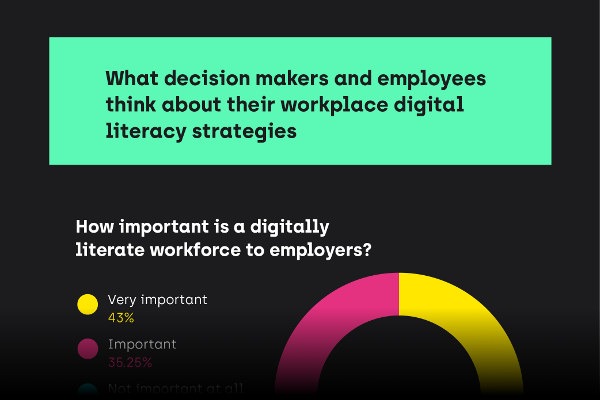
Digital technology has drastically changed the workplace. From the introduction of computers and the internet to the development of IT systems and wireless technology, it has become increasingly advantageous for businesses in all industries to ensure employees are as ‘digitally literate’ as possible. Digital literacy simply refers to an employee’s ability to successfully carry out the aspects of their role which involves digital communication and accessing information on digital platforms. With technology expanding into all job roles, in today’s day and age, it’s vital that not only those who work in IT are digitally literate, but instead, all staff are well trained and provided with the support they need.
With a number of hidden costs associated with ‘digital illiteracy’, including suboptimal work, a breakdown in digital communications and general inefficiency, can businesses really afford not to have a well-implemented digital literacy strategy in place?
Here at illumo digital, in an attempt to better understand how employees and businesses really feel about digital literacy – from what it is and how important they believe it to be to who is responsible for digital training and support and what strategies are currently in place – we surveyed 400 employees and business decision-makers to get their take on digital literacy.
Here’s what we found:
A bleak outlook? Our findings at a glance:
- 20% of businesses have no digital skills strategy in place.
- Almost a fifth of all employees said they had never received any digital skills training.
- 65% of decision makers think the ‘extra cost’ involved in skills training and a ‘lack of resources’ is to blame for the digital skills gap.
- The 35-44 age group admit to struggling ‘very often’ with digital tasks – more than any other age group.
- Almost half of all businesses currently do not test their employees’ digital literacy skills.
- 90% of employees already use Google or online courses as a way to improve digital literacy.
- Freelancers and those who work for SMEs struggle more than employees of large organisations.
- 75% of employees think their job will be more digitally demanding in five years’ time.
Are employees at risk of falling behind due to their lack of digital literacy awareness?
Well, according to our findings, yes – some employees are at risk of falling behind when it comes to their digital literacy skills. We found a fifth of all businesses currently have no digital literacy strategy in place at all, despite the fact that 80% of employees admitted to struggling with digital tasks, ranging in severity from ‘sometimes’ to ‘everyday’. This lack of a strategy in some businesses is reflected in the fact that 18% of employees told us they had ‘never’ received training from their employer regarding digital skills, or had simply not had any digital skills training since they had arrived at the company. Perhaps predictably, when asked why they thought businesses were hesitant to invest in digital literacy strategies, 65% of decision-makers pointed to the ‘extra cost’ involved and a ‘lack of resources’. This suggests that even if the desire is there to provide more in-house training, many businesses are not yet willing to make a financial commitment.
From the 80% of businesses who had a static approach in place, we found that in many cases, employees still believed more could be done in the way of support and training programmes. 55% of employees suggested that the addition of formal training programmes, weekly lessons, and mentoring programmes would be the most effective methods of improving digital skills. And while a combined 82% of decision makers said they have at least one of these three approaches already in place, a significant 20% also admitted to either thinking it is ‘not important enough to require budget’ or simply that they had ‘never thought to allocate budget to digital literacy training’.
With the process of outsourcing the design and development of e-Learning platforms easier and more affordable than ever, for example, neither of these reasons should be an excuse. Even basic, well-implemented e-Learning platforms that staff interact with on a regular basis can be enough to improve and support the digital literacy skills of your staff, saving you time and money going forward.
What’s the future of digital literacy strategies?
When asked what digital literacy solutions their businesses are likely to implement in the next five years, 20% of decision-makers highlighted online surveys as the most likely method of introducing digital literacy training, while investing in new technologies (17%) and further mentoring (15%) were also listed as the second and third most popular strategy methods for future implementation respectively. Again, this suggests that even the businesses who are willing to invest in digital literacy training favour the cheaper-to-implement methods.
However, with 75% of employees believing that their job will be more digitally demanding in five years’ time, and 90% admitting to already having to use Google or online courses as a way to improve digital literacy for their role, our study suggests now is the time businesses should look to invest in, and implement, new forms of digital literacy strategies.
What decision-makers and employers don’t appear to understand is just how quick, simple and affordable high-quality digital literacy training solutions can be. Strategies made up of custom-built training software and e-Learning platforms developed and installed by outsourced IT experts, as well as regular face-to-face on-the-job training courses, are readily available and very affordable in today’s market. Remember, despite common preconceptions, the lack of such a strategy could actually be costing your business far more than you think it’s saving.
As experts in software development for private and public sector organisations, at illumo digital we are big proponents of well-implemented digital literacy strategies and believe that every employee has the right to the digital skills training they need. But what do you think? Let us know on social media using the hashtag #DigitallyFluent.


